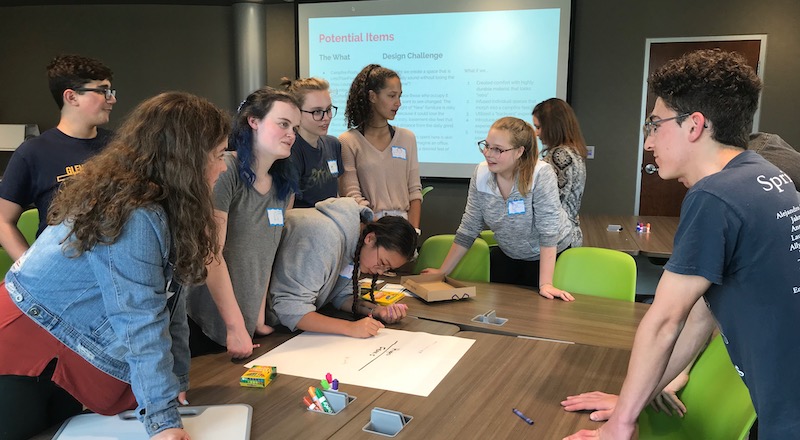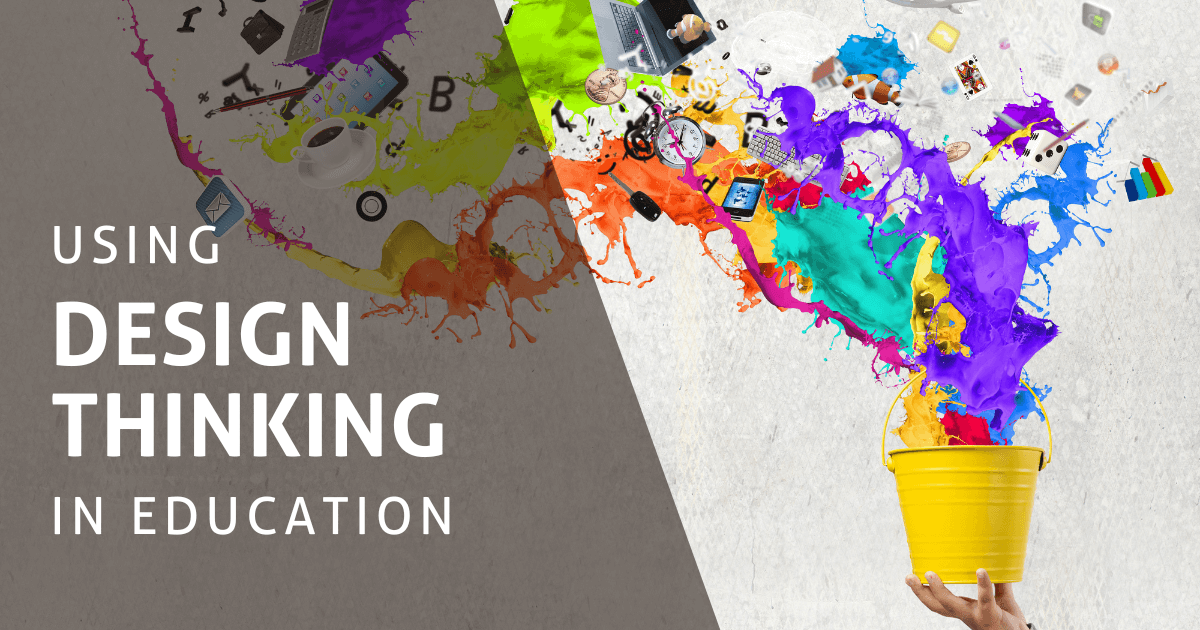How are you reading this blog? Are you using a phone, sized to fit perfectly into your hand? Are you on a computer, with a mouse and keyboard designed for speed and ease-of-use? All of these items were created using design thinking—a mindset that centers the user when creating a product. Design thinking involves finding the problems a product should solve by understanding and anticipating users' needs. This week, we’re taking a closer look at incorporating design thinking in K–12 schools and how developing this skill will benefit students for life. It’s not just about designing creative solutions to problems in the classroom. Competencies in this area of creative thinking can also help students create the very futures they want.
Design Thinking and Supporting Makerspaces
The Maker Movement provides great opportunities for students to leave their comfort zones and take part in hands-on, passion-based problem solving. So, a makerspace is the perfect place to introduce and practice design thinking. After all, design is the heart of a makerspace. Almost all makerspace projects, from the simplest cardboard craft to the most intricate 3D-printed build, involve some form of design. As kids work on makerspace projects, design constantly comes into play—whether they realize it or not.
Infusing design thinking with play and empathy.
To create safe environments for kids to boost their design thinking skills, educators can focus on play and empathy. Why combine these two skills? Play and empathy are exactly what students need to create good designs. While empathy helps students recognize how their projects could help others, play develops the creativity they need to design an effective solution. Play also takes pressure out of learning and encourages kids to try new things in a relaxed atmosphere. Since makerspaces are fairly open environments, combining play with design thinking is often easier to accomplish than in the classroom. And practicing these skills now will better equip students to alter and improve their designs in the future. This also helps them consider all aspects of a problem rather than just the end result.
How design thinking applies beyond the makerspace.
Design experiences can also help guide students through the different phases of problem solving. They can apply design principles not only to their makerspace creations but also to their personal failures and successes. A design-centered mindset can help kids see why one approach may have worked while another might have led to struggles. Plus, it can increase students' perseverance by demonstrating that most problems can be resolved—they simply need a creative solution. Overall, design thinking can increase students' awareness of the problems around them and possible solutions. Through careful experimentation and creation, they can achieve optimal results and boost their critical and creative thinking in the process.
Project-Based Learning and Design Thinking
Design thinking opportunities are largely hands-on, so, naturally, there are many ways to weave them into project-based learning (PBL). Many teachers have implemented project-based learning in their classrooms, providing numerous benefits for students—including the chance to develop their design skills. Usually, PBL activities are more extensive, as opposed to quick projects that students complete in one or two class periods. Many times, these projects involve solving pressing societal problems in the local community, helping kids develop design skills while actually on the job. Students will see how their solutions will unfold over a longer period of time, as opposed to simply getting the job done. This creates more real-world relevance, as STEM professionals are constantly accounting for both short- and long-term failures and successes.
Classroom design thinking.
Design thinking in PBL doesn’t have to be all physical work, however. Students can still apply their creative skills when utilizing computer programs, for example. If they’re researching for an essay, their design thinking background might help them understand the flow or structure of their argument. If they're 3D printing components to use in projects, they are more likely to use the design process along the way. Design and PBL are relevant in almost every academic subject—STEM or not—including ELA, science, SEL, and history. Plus, students can try new roles, experience leadership, and execute other team-based responsibilities.

Design Thinking and Problem Solving
In today’s educational climate, different teachers embrace different types of instruction. Some classrooms feature many hands-on projects, while others include more inquiry-based or personalized learning. These various classroom models help kids achieve different outcomes and allow them to explore new ideas. They can put different skills to use in each environment, helping them achieve big-picture goals while working to identify problems and creating solutions. But no matter the environment, educators can encourage design thinking—whether instruction is project-based, inquiry-based, or personalized. Kids can find many different ways to solve problems, but design thinking helps them find the most optimal solution.
Design thinking for students and others.
Teaching students about design thinking does more than simply help them solve problems. The design process is structured, meaning that students must first clearly identify a problem and the impact of a potential solution. Since kids must prepare before beginning a project, lead-up and design thinking strategies become more valuable. Plus, since design projects often impact other people or groups, students tend to take them more seriously and enhance their quality of work. This helps them see that, for this particular project, their work is impacting someone else—helping them go beyond earning a grade or simply completing assignments.
What makes a good design thinker?
Despite the clear steps of the design process, it isn't always linear. Students routinely have the opportunity to revisit previous ideas or failed attempts in order to improve them. This helps them better define problems and explore opportunities to work towards a more clearly designed solution. As students use these strategies more regularly, they develop the proper mindset for using design thinking in everything they do. Good design thinkers can empathize, define, ideate, prototype, test, revise, and implement the best solutions for any situation.
Design Thinking’s Place in the Classroom
For school leaders who love creating innovative learning opportunities, design thinking is commonly in the mix. To be the most prepared for the future, students should be able to solve problems in various contexts. Not surprisingly, this is where having design skills might serve them particularly well. Typically, there's more than one solution to a problem, and the most efficient one may depend on the steps students take. Having a solid background in design thinking can speed up this process and help lessen the chance that they overlook something. For this reason, design thinking can help students progress in just about any 21st century classroom.
Students and teachers growing together.
When pushed to utilize a design thinking approach, it’s not surprising that students tend to become better architects of problem solving. They develop a sense of independence that simultaneously helps teachers by allowing them to spend more time working directly with students who need more assistance. Ultimately, this approach can get every student thinking and solving problems on their own. To sell the premise of design thinking, however, educators must fully believe in it and their ability to illustrate it. This helps students embrace the principles of design thinking and use this approach as often as they can. With a simple shift in mindset, educators can lead these kinds of changes in most classrooms.
Lesson planning to incorporate design thinking.
Design thinking is not just for students, though. Like students, teachers can design their lessons with others in mind and consider how each student might react. And if one approach fails, they can try something else. Teachers have to decide what’s best for their lessons, their students, and even their classroom layout and seating arrangements. One common characteristic of classrooms that emphasize design thinking is a circular pattern of desks. This layout encourages teachers to work directly with students, offering feedback rather than simply lecturing. As education leaders try to move away from the sage-on-the-stage teaching model, hands-on learning is a common solution. In experiencing this type of learning, students can work on developing specific design thinking skills. When teachers design lessons with purpose and help students activate design thinking, there's a greater chance they both succeed.

Bringing Design Thinking to Schools
Guiding students towards design thinking can offer creative advantages and prepare them for future problem solving. Traditionally, students think teachers have the answers to everything, but that's not necessarily true. We want kids working with educators (or without) to find solutions collaboratively rather than being told what's right. Meaningful, hands-on challenges are a good starting point for students to incorporate design thinking in their daily lives. Design thinking also disrupts traditional instruction, changing the focus to hands-on learning. By putting designs into practice with their hands, students can recognize their failures, successes, and opportunities to improve. And with the help and guidance of teachers, kids will be able to take design thinking into any future field.
For the latest EdTech, STEM, and 21st century education news, follow us on Twitter and Instagram. Like us on Facebook, too, or sign up for our newsletter for our latest product announcements and offerings. If you have an idea for an Eduporium Weekly theme, send us a message on social media or comment below.



